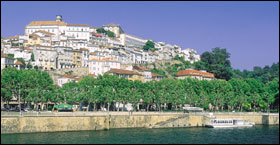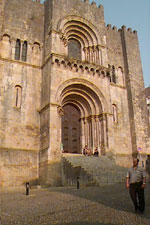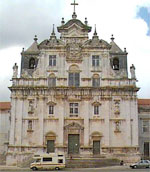
COIMBRA
Coimbra was first capital of the Portuguese Kingdom,
founded in 1143 by D. Afonso Henriques, the
first King of Portugal. The city name is
derived from the bishopric of Conimbriga
which moved to the area in the 9th century.
| Lively Coimbra is renowned for its university, which was established in the 13th century. Centuries of history lie under by a fine mantle of huddled white washed houses, intersected by endless winding streets, steps, arches and lanes that decorate this beautiful, centuries old Upper Coimbra. |
|
|
|
|
Overlooking the city stands one of the oldest and most beautiful Universities in Europe, dominated by its Baroque tower. Founded in the year 1290, the University has a magnificent Baroque library, a chapel and gates of style "Manueline". |
|
Sé Velha - The Old Cathedral, an austere, fortress-like structure, was started in the 12th century. Despite modifications in the 16th and a restoration in the 19th century, it remains perhaps Portugal's finest Romanesque church. The gilded wood altarpiece was carved by the Flemish sculptors Olivier de Gand and Jean d'Ypres in the late 15th to early 16th century. There is an impressive 13th-century Gothic cloister. |
 |
 |
Sé Nova (New Cathedral) - Built on the 16th Century by the Jesuits, this cathedral is situated inside the main University campus. |
| Machado de Castro Museum - A 16th Century palace that was formerly the Bishop's residence. On display are collections of paintings, sculptures, gold works and tapestries, from ancient art up to the 20th Century. In the underground there is an amazing Roman crypt, with a maze of passages where are exhibits with items from that period. |  |
 |
Botanical Gardens - The Coimbra Botanic Gardens (Jardim Botânico) are the largest and oldest in Portugal, founded in the 18th century, and covering 20 hectares (50 acres). There is an enormous collection of all kinds of plants and an attractive sunken garden. Among its wide variety of species, visitors can find some tropical and sub-tropical plants and 51 different species of Eucalyptus. A 16th-century aqueduct passes across the garden. |
| Portugal dos Pequeninos - Children and most adults will enjoy the Portugal dos Pequenitos (Portugal in Miniature), a park with scaled-down versions of Portugal's most famous buildings, distributed amid vibrant sculpted gardens and exhibits from Portugal's former colonies such as Angola. Mozambique and Timor. |  |
| Santa Clara-a-Velha Monastery is a 13th century Baroque monastery (rebuilt on the 17th century) that is located on the left bank of the Mondego river. Santa Clara-a-Nova Monastery is a 17th century monastery located on the left bank of the Mondego river. It is the resting place of the remains of Queen Santa Isabel who is revered as a Saint. |
More information about Coimbra can be obtained
by following this link.
SURROUNDINGS